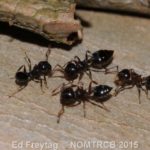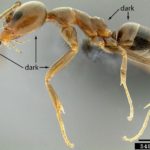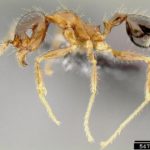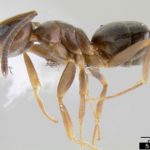General Information
Several species of ants cause problems inside schools. Ants are social insects. Their nests or colonies can be found indoors and out, although some species have preferred nesting sites. A nest contains one or more queen ants laying eggs and being cared for by worker ants. Worker ants– sterile or non-reproductive female ants–tend the queen and brood (eggs, larvae and pupae) and forage for food. Foraging ants can invade buildings from colonies outdoors.
Nests often can be located by following “trails” of foraging ants. Indoors, ants nest almost anywhere. For instance, Pharaoh ants readily nest in attics, appliances, linens, heating ducts, wall voids and light switches or fixtures. Killing foraging ants rarely solves an ant problem in the home because the colony remains unaffected.
During certain times of the year, most species produce reproductive’s, winged male and female ants that leave the nest to mate and establish new colonies. When winged ants swarm inside, their colony is likely to be located somewhere inside.
Ants form new colonies in several ways. Most are started by a newly mated, winged reproductive, now called the queen. After finding a suitable nesting site, the queen loses her wings and begins laying eggs, which hatch into legless, grub-like larvae. The queen feeds the larvae as they develop through several stages in which they molt and grow between each stage. Afterward, they form pupae and soon emerge as adult ants. The eggs, larvae and pupae are often referred to as “brood”. Once worker ants have developed, the queen no longer needs to care for the brood. The brood is cared for by worker ants. Cooperative brood care is important to successful baiting because this is one way bait toxicants can be passed through a colony.
Some ant colonies have more than one queen, and mating may occur within the nest without swarming. These ants form new colonies when one or more queen ants, along with some workers and brood, leave the nest and move to a new location.
Ant colonies do not nest in permanent locations; frequently entire colonies move from one nesting site to another almost overnight. Particularly during very wet or abnormally hot and dry weather, ant colonies whose nesting areas are flooded or lack food and water often migrate indoors. It is not uncommon to receive complaints about ants after a heavy rain.
Worker ants foraging for food and water become a concern when they infest food or other items in the structure. Although most ants consume a wide variety of foods (they are omnivorous), certain species prefer some types of foods and some even change their preferences over time. When baiting ants that can change their diet preference, it is important confirm that the ants are feeding on bait being offered. So, if the ants are not feeding on protein-based bait, try sweet-based bait.
Foraging workers of some ants establish temporary chemical (pheromone) trails that help other ants find food and water. These species can “recruit” other ants to a resource quickly and in high numbers. Food is brought back to the colony and fed communally among the other members of the colony, including the queen(s) and brood, a process called trophallaxis.
Identification
| Species | Description | Where to Look | Recommended Control Tips per Species |
|
Acrobat ants Crematogaster spp
|
Workers are one size, between 1/16 inch and 1/6 inch depending on species.Color is variable, but frequently the head and thorax are reddish-brown, and the abdomen is black.Have two backward-pointing spines on the thorax.Waist (pedicle) has two nodes and is attached to the upper side of the.Gaster is heart-shaped and is often held upright over the body when the ants are disturbed | These ants’ nest in water-damaged or water-stressed wood similar to carpenter ants. Inside: they are found in building voids and insulation. Outside: are found in soil, leaves or wood. They can trail along fence or other structural lines. They will trail and enter buildings by any means. They are active during the day and prefer sweet foods.Often feed on the sugary excretions of honeydew-producing insects (e. g. aphids or scales). |
Locate the nest if possible, to apply treatment there. Place sweet or protein baits along foraging trails is the first option. Results may vary if populations are large. Treat outdoors using a microencapsulated or wettable powder formulation insecticide. Follow trails back to nesting site. If found indoors in wall voids, use a dust or aerosol that is labeled for wall void use. Inspect a and reevaluate in two weeks. Make sure customer is following all IPM steps to help reduce competition for baits. |
|
Argentine ant Linepithema humile
|
Workers are one size, about 1/8 inch and light to dark brown. The waist (pedicel) has one node. The tip of the gaster lacks a circle of hairs. They may emit a stale greasy or musty odor when crushed. These ants do not have a stinger. |
Inside: can be found near water pipes, sinks, potted plants and water leaks. Outside: can be found in moist areas under logs, boards, stones, concrete slabs, debris, mulch, leaves and pine straw. Usually nest near a moisture source. Workers follow trails when foraging. They commonly tend honeydew-producing insects (e.g., aphids). Sweets are the favored food, but they will feed on most any food source. |
Colonies can be very large and have multiple queens and nests. Monitor areas of historic infestation. Bait as early in the season as possible to prevent buildup of large populations. Respond to protein baits early in the season; consider using a liquid, sugar-based bait during the summer. Make sure to use enough product, as the label direction allows. Perimeter liquid treatments with products containing fipronil are a popular option; however, the label limits the number of times per year it can be used Do not apply perimeter spray treatments in the same area as baits Follow trails back to nests, treating trails and nests (not allowed with fipronil) to remove breeding sites. This ant tends honeydew producing insects, so controlling plant-feeding insects may aid in control. |
|
Bigheaded ant Pheidole spp
|
Workers are dimorphic (major and minor workers). This ant receives its common name from the large-sized head of the major worker, or “soldier.” Minor workers are small (2 mm) reddish brown ants. Majors are much larger (3 to 4 mm), but only constitute about 1% of foragers. Petiole of both worker forms is two-segmented and the post-petiolar node is conspicuously swollen. Antenna is twelve-segmented with a three-segmented club. Entire body is covered with sparse, long hairs. |
Inside: exterior walls of structures as ants climb into attics or other natural or artificial voids. Outside: can be found nesting in disturbed soils, lawns, flowerbeds, under objects, such as bricks, cement slabs, or flowerpots, around trees or water pipes, along the base of structures, and walkways, where displaced soil is usually observed from the action of ants digging below the surface.Note: this ant can expand into neighboring areas by following along these lawn-walkway edges or roadways. Population movements into new areas to establish nests and subsequent displacement of other ant populations can be rapid. |
Trophallaxis is frequently observed between two minor workers, or a minor and major worker which is important with baiting. Bait preference: oil-based fire ant bait, also will feed on protein, glucose, or lipids. Be sure to read the product label to make sure that the product also lists big-headed ants. If the colonies (or nests) can be located, it is best to eliminate the colonies by using a residual insecticide soil drench to treat the nest. |
|
Ghost Ant Tapinoma melanocephalum  Ghost ant tending mealybug
|
Workers are one size, about 1/16 inch. The head and thorax are dark brown to black. Antennae, waist (pedicel), gaster and legs are pale in color. Waist has one flattened node hidden by the base of the gaster. The tip of the abdomen lacks a circle of hairs. Can emit a nauseous, rotten coconut-like odor when crushed. |
Inside: can nest in cabinets, walls and potted plants and behind baseboards. Outside: can be found under logs, stones, potted plants, etc. These ants prefer sweets but will eat insects. They tend insects for honeydew. Because of their high-water requirements, they can be found trailing to water sources. Bait preference: sweet and protein |
Reduce moisture sources, including condensation, and leaks. A thorough inspection inside and out is crucial to determine ant nest locations. If possible, follow the trails back to the nest and treat the nest. If treating the trails with bait check within one or two days to see if the ants are feeding. If not, relocate the bait. Indoor colonies nesting within voids can be controlled with baits. Access of foragers entering from outdoors through cracks and crevices or screens may be restricted with barrier sprays if necessary. It may be necessary to pre-bait with sweets if nests cannot be located to draw ants out. |
|
Odorous house ants Tapinoma sessile
|
Workers are one size, about 1/8 inch and black to brown.Waist (pedicel) has one segment with a flattened, and difficult to see node.The tip of the abdomen lacks a circle of hairs.Can emit a disagreeable, rotten coconut-like odor when crushed. | Inside: nests are found inside wall voids, around heaters and hot water pipes and in crevices around sinks and cupboards.Outside: nests are shallow, often under objects such as rocks, landscape timbers and mulch.Prefer sweets but will eat food with high protein (meat or carrion).This ant tends honeydew producing insects, so controlling plant-feeding insects may aid in control | Control of foraging odorous house ant workers can be accomplished using baits. The workers carry the baited material back to the nest, eliminating the colony.Many different types of bait are available. Choose baits designated for sweet-loving ants.Place the baits in areas where along foraging trails and make certain that children or pets cannot reach them.Maintain enough of the bait to satisfy the colony by replacing used baits.It may require two weeks or longer to obtain control with baits.Follow trails back to nests, treating trails and nests to remove breeding sites.Can nest in wall voids, so dusts are an option; however, once a void is dusted, baits will not generally be effective in subsequent treatments. |
|
Pharaoh ant Monomorium pharaonis
|
The workers are one size, about 1/16 inch.Yellow to reddish colored with a dark gaster tip.Waist (pedicel) has two nodes, and the antennae are 12-segmented with a three-segmented club. | Inside: nests are found in wall voids, behind baseboards, in furniture or other warm humid areas near food and water. The colonies tend to be large, have multiple queens and are prone to “budding.”New nests can be formed with as few as five workers, 10 immatures and one queen. Applications of fast-acting liquid or dust insecticides may cause colonies to divide and disperse, worsening the problem. | This ant lives almost exclusively indoors.Baiting is usually the only method of effective control.Use one bait station per line of foraging ants.Do not spray. Sprays have been observed to “split” colonies, making the problem worse by spreading ants to different areas of the structureHistorically, this ant has responded to sweet, protein and oil-based baits. |
Suggested Thresholds
First sign of ant trails consisting of 6 or more ants. When only winged (reproductive) ants are present in such sites, no treatment is probably necessary. However, the IPM technician should be consulted to ensure that such insects are not confused with termites.
Monitoring and Inspection
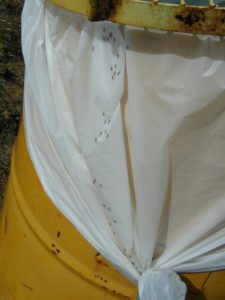 Identifying the problem ant is the most critical step to solve a persistent problem. Monitoring for nuisance ants to determine which species are present is primarily visual inspection for foraging individuals, trailing ants or colonies. Additionally, bait stations may be monitored for evidence of feeding. Adhesive-coated monitoring traps may also capture ants. Finally, index cards can be baited with honey or sugar-water solutions or vegetable oil to attract and capture ants to identify which species are active in a specific area.
Identifying the problem ant is the most critical step to solve a persistent problem. Monitoring for nuisance ants to determine which species are present is primarily visual inspection for foraging individuals, trailing ants or colonies. Additionally, bait stations may be monitored for evidence of feeding. Adhesive-coated monitoring traps may also capture ants. Finally, index cards can be baited with honey or sugar-water solutions or vegetable oil to attract and capture ants to identify which species are active in a specific area.
On arrival at a site, the technician can place these “traps” and then check and remove after 30 minutes. Individual ants captured for identification purposes should be held in a small vial to preserve key identifying characters to be sent to experts for identification, or brought back to the pest control companies entomologist.
Inspection practices should include checking for vegetation touching buildings, mulch contacting foundations, trash cans or dumpsters placed too close to building entryways, exposed food, inadequate clean up of spilled food or drink, unrinsed recycling, unsealed openings through the building exterior and missing or damaged door sweeps and door and window seals. Nests can also often be located by visual inspection and/or following trailing ants.
Nonchemical Control Measures
Sanitation/Cultural Control Measures
- Disrupt ant trails by applying District-approved all purpose cleaners. Wash trails with cleaner to remove scents that ants use to return to a site with food.
- Preferred management options include prompt clean up of spills, proper food storage and waste handling, preventing access to water by fixing plumbing leaks and repairing damp wood, eliminating harborage and access to the building by sealing cracks and crevices, and trimming vegetation and moving mulch away from buildings.
- Exterior lighting should be positioned to avoid attracting crawling and flying insects to building entryways at night, which can then attract ants and other pests to these entryways to feed on dead insects.
Physical/Mechanical Control Measures
- Remove individual ants using a vacuum or wipe or wash away.
- Eliminate the access point where ants are entering by sealing cracks, installing door sweeps, repairing door and window seals, etc.
- Store food items in sealed containers.
- Use liners for waste containers and empty at the end of the day so that food is not left in the building overnight.
- Place exterior trash cans and dumpsters away from building entrances.
- Fix plumbing leaks, gutters that hold water and damp wood to eliminate access to water.
- Trim vegetation away from buildings to prevent ant access.
- Rake back mulch at least 6” from building foundations to ease inspection for ant trails.
- Position exterior lighting to avoid attracting crawling and flying insects to building entryways at night.
- Use sodium vapor/yellow or LED bulbs for exterior lighting to reduce attraction to insects.
Chemical Control Measures
At times, non-chemical methods alone prove insufficient to solve the problem. Integrating a pesticide into your management program may be necessary to gain control of the ant problem.
Pesticides must be used in accordance with their EPA-approved label directions. Applicators must be certified to apply pesticides and should always wear protective equipment during applications. All labels and Safety Data Sheets (SDS) for the pesticide products authorized for use in the IPM program should be maintained on file. Do not apply these materials when buildings are occupied, and never apply them where they might wash into drains or sewers.
When treating ants, all baits and dusts should be placed in cracks, crevices, and in precise areas where ants are active.
Insecticide-impregnated plastic barriers can also be used to protect inaccessible wiring and electrical boxes.
Ant Baits
Baits greatly reduce the amount of pesticide that must be used to kill ants. Foraging ants take the bait back to the nest to feed to other members of the colony resulting in colony death. Even if the queen is not killed, baits will usually stop an ant invasion. If a colony has been starved by effective sanitation measures, baits will be more readily accepted.
Always place baits out of sight and reach of children, or, if this is not possible, use baits at night or on weekends and remove when children are in school. Some ants are very susceptible to baits, some are less so. There are many reasons for these differences, only some of which we understand. If you are having difficulty in controlling ants with bait, the following points may be helpful:
- It is important to correctly identify the species of ant that is invading the school since each species differs in its food preferences. Some baits contain a sweet attractant and others use a protein or oily attractant. Therefore, the attractant in the bait must be preferred by the type of ant identified. If you cannot determine the type of attractant by looking at the label, call the manufacturer for more information. You should also ask if the company has data to support the efficacy of their product against the ant species you are dealing with.
- After setting out bait, observe to see if the target ant is taking the bait.
- Ant colonies have changing nutritional requirements that can pose problems in baiting. A colony that accepted protein bait one week may be more interested in sugar bait the next.
- The nesting and foraging environment can also affect bait acceptance. Ants nesting and foraging in dry areas will be more interested in baits with high water content than will ants nesting in moist environments.
- When there are several competing ant species in one area, non-target ants may accept your bait more readily than the pest ant and, in some cases, prevent the pest ant from getting to the bait.
- Do not spray pesticides when using baits. Bait stations contaminated with pesticide are repellent to ants, and sprays disperse the ant infestation, making it more difficult to place baits effectively.
- Place bait stations along foraging trails, but do not disturb ant trails between the nest and the bait. Killing the ants or disturbing the trails prevents the ants from taking the bait back to the colony to kill nest mates.
- Do not apply bait until an ant problem is noticed. If you use baits routinely without evidence of ants you may attract ants into the building.
- Some baits come packaged in plastic disc “bait stations” that comes with double-sided tape so they can be attached to various surfaces out of view. It is important to remove bait stations once control is attained because the stations may serve as harborage for cockroaches.
- Some baits are formulated as granules or gels that can be injected into wall voids through small holes. Gel baits can also be placed near ant trails in inconspicuous places where they will not be disturbed.
Evaluation Methods
When using bait methods allow approximately 6 to 8 weeks for effective population reduction.
Compiled from publications by Mike Merchant, Karen Vail, Faith Oi, S. Darr, T. Drlik, H. Olkowski, and W. Olkowski
